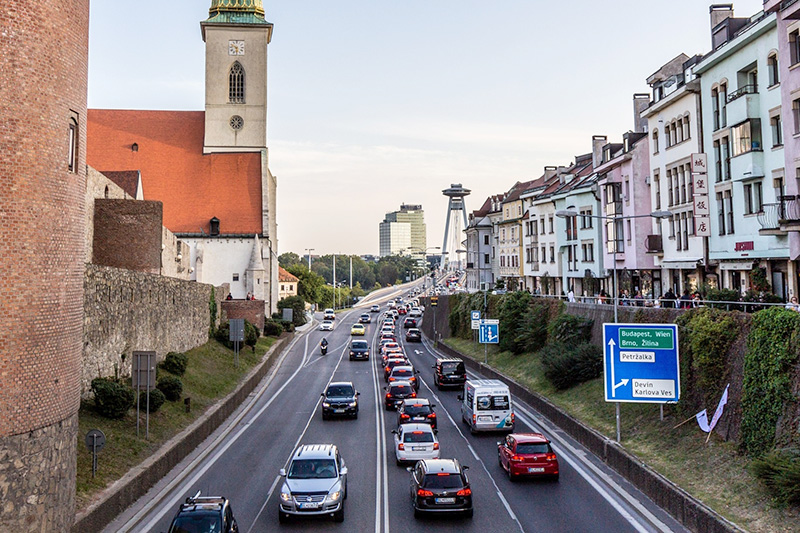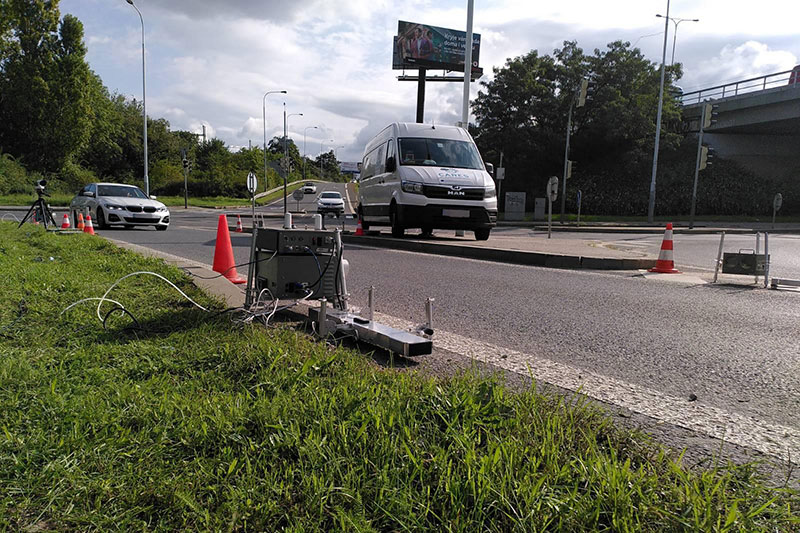Real-world emissions from remote sensing: An update of the TRUE rating

Today we're publishing the results of our most recent real-world motor vehicle exhaust emissions measurement campaign, conducted in Paris in the summer of 2018 using remote sensing technology. This new data is also now incorporated into our existing database of on-road vehicle emissions measurements, and used to provide a third update of the TRUE rating of real-world NOx emissions from passenger cars.
The TRUE rating was last updated in December 2018, to reflect data collected via remote sensing measurements in London made in the winter of 2017/2018. In the summer of 2018, we carried out a second remote sensing campaign, this time in Paris, during which we obtained more than 180,000 new measurements of exhaust emissions from in-use vehicles at three locations in the city. More than 70% of these vehicles were passengers cars.
This Paris data is unusual in that it was collected within a very narrow time window: it is the largest European dataset from any remote sensing campaign lasting less than a month. It is also the only dataset in which a large fraction of the exhaust samples was obtained at ambient temperatures above 30°C. That is noteworthy because those temperatures are outside the typical range of the laboratory type-approval conditions for light-duty vehicles.
In comparison to other European cities for which we have remote sensing data, the Paris fleet contains a greater share of diesel cars, up to 64%. The Paris fleet is also relatively new: the average age of a vehicle is 5.8 years, compared to the French national average of 8.8 years. For that reason, more cars certified to the Euro 6 were sampled during the Paris campaign than cars of any earlier Euro standard, despite the fact that Euro 6 was introduced only four years earlier.
With the addition of the Paris data, the remote-sensing database on which the TRUE rating is based has grown to 1.2 million measurements, with a 75% increase for Euro 6 cars alone.
The TRUE rating still consists in a three-color scheme, in which green/good = high statistical confidence that the vehicle meets an average on-road NOx below 90 mg/km; red/poor = exceeds 180 mg/km; and yellow/moderate = in between (see here for a full explanation of how the rating is derived).
The methodology behind the TRUE rating remains unaltered, but we have raised the bar for ourselves somewhat. Initially we required a minimum of 30 measurements to support our findings; below that number we did not issue a TRUE rating. The additional data obtained from the Paris campaign allows us to raise that bar to a minimum of 50 measurements to issue a rating, improving the robustness of our results without sacrificing market coverage. Models we no longer rate because they do not meeting the 50 measurement minimum represent less than 1% of the market, and these are mostly the oldest vehicles, leaving the fleet, or niche market models. The loss of those models from the rating system is counterbalanced by the addition of new models that we can now rate.
Fewer than 5% of cars saw changes to the TRUE rating based on this update, and those are virtually all petrol cars. In about two-thirds of these cases the rating was downgraded, from good to moderate or moderate to poor. As I explained the last time we updated the TRUE database, here, a likely cause of increasing emission levels is simply wear on and deterioration of the engine and emissions control systems from age and normal use.
Share of passenger vehicle families receiving a green, yellow, or red rating grouped by fuel type and Euro standard.
The overall conclusions of the TRUE rating remain unchanged. The greatest majority of diesel vehicles, including Euro 6 vehicles, are still rated red. Petrol cars of the latest standard, Euro 6, show generally low NOx emissions, in some cases moderate, and no poor cases. Allegedly cleaner diesel 6d-TEMP vehicles are entering the market, but in Paris fewer than 1% of all measured Euro 6 vehicles were certified to this most recent version of the standard.
The new data permits us to rate new families of vehicles. An example is models from the luxury brand of the Renault-Nissan group, Infinity, that use the 2,143 cubic centimeter diesel engine block originally from Mercedes. Similarly, we can rate models from the Fiat Chrysler group using a diesel engine of the same size. (Both receive a poor rating.)
New models from the PSA group are starting to play best in the diesel category. Those using the new 1.5 BlueHDi engine have among the lowest emissions for diesels, although these are still rated only moderate. It is not a surprise that these models perform better, because the engine and associated aftertreatment systems were specifically developed by the PSA group to meet the Euro6d-TEMP regulation. They were also among the first models available for order in late 2017. The PSA group had voluntarily certified them to lower on-road NOx emissions than what the regulation requires. The declared maximum value for NOx emissions during a Real Driving Emissions test was 120 mg/km, instead of the 168 mg/km legally required.
Since the completion of the Paris campaign, other remote-sensing campaigns have been conducted in European cities, including Zurich, Krakow, and Antwerp. The overall database of real-world, on-road vehicle emissions measurements continues to grow, and we aim to continue adding to the data on which the TRUE rating is based. A year from now, the new type-approval framework will require member states to conduct their own market surveillance. To prepare for that task, building evidence based on real-world emissions has never been more crucial. The TRUE rating is showing how it can be done in a cost-effective manner using remote-sensing.
Table of families for which the TRUE rating has changed based on the September 2019 update:
|
Fuel |
Emission Standard |
Manufacturer |
Engine displacenent (l) |
Old rating |
New rating |
|
Petrol |
Euro 3 |
BMW |
2.2 |
Poor |
Moderate |
|
Petrol |
Euro 3 |
Daimler |
0.6 |
Poor |
Moderate |
|
Petrol |
Euro 3 |
Ford Motor Company |
2.0 |
Poor |
Moderate |
|
Petrol |
Euro 3 |
Suzuki |
1.3 |
Moderate |
Poor |
|
Petrol |
Euro 3 |
Volvo |
1.8 |
Moderate |
Poor |
|
Petrol |
Euro 4 |
Daimler |
0.7 |
Good |
Moderate |
|
Petrol |
Euro 4 |
Daimler |
5.0 |
Good |
Moderate |
|
Petrol |
Euro 4 |
Ford Motor Company |
2.0 |
Poor |
Moderate |
|
Petrol |
Euro 4 |
General Motors |
1.4 |
Good |
Moderate |
|
Petrol |
Euro 4 |
General Motors |
2.0 |
Poor |
Moderate |
|
Petrol |
Euro 4 |
Honda |
1.2 |
Good |
Moderate |
|
Petrol |
Euro 4 |
Mazda |
1.4 |
Good |
Moderate |
|
Petrol |
Euro 4 |
PSA Group |
1.7 |
Moderate |
Poor |
|
Petrol |
Euro 4 |
PSA Group |
2.9 |
Moderate |
Good |
|
Petrol |
Euro 4 |
Subaru |
2.0 |
Poor |
Moderate |
|
Petrol |
Euro 4 |
Volkswagen Group |
4.8 |
Good |
Moderate |
|
Petrol |
Euro 4 |
Volvo |
3.2 |
Moderate |
Good |
|
Petrol |
Euro 5 |
Fiat Chrysler Automobiles |
1.2 |
Good |
Moderate |
|
Petrol |
Euro 5 |
Fiat Chrysler Automobiles |
0.9 |
Moderate |
Good |
|
Petrol |
Euro 5 |
Hyundai Motor Company |
1.0 |
Moderate |
Good |
|
Petrol |
Euro 5 |
Renault-Nissan |
1.1 |
Good |
Moderate |
|
Petrol |
Euro 5 |
Suzuki |
2.4 |
Good |
Moderate |
|
Petrol |
Euro 5 |
Volkswagen Group |
2.5 |
Good |
Moderate |
|
Petrol |
Euro 6 |
BMW |
1.2 |
Poor |
Moderate |
|
Petrol |
Euro 6 |
BMW |
3.0 |
Good |
Moderate |
|
Petrol |
Euro 6 |
Daimler |
4.7 |
Good |
Moderate |
|
Petrol |
Euro 6 |
Fiat Chrysler Automobiles |
1.6 |
Good |
Moderate |
|
Petrol |
Euro 6 |
Ford Motor Company |
1.6 |
Good |
Moderate |
|
Petrol |
Euro 6 |
Ford Motor Company |
2.0 |
Moderate |
Good |
|
Diesel |
Euro 6 |
Jaguar Land Rover |
2.0 |
Moderate |
Poor |
|
Petrol |
Euro 6 |
PSA Group |
1.0 |
Good |
Moderate |
|
Petrol |
Euro 6 |
PSA Group |
1.6 |
Good |
Moderate |
|
Petrol |
Euro 6 |
Renault-Nissan |
1.0 |
Good |
Moderate |
|
Petrol |
Euro 6 |
Renault-Nissan |
1.6 |
Good |
Moderate |
|
Petrol |
Euro 6 |
Suzuki |
1.4 |
Good |
Moderate |
|
Petrol |
Euro 6 |
Toyota |
2.5 |
Moderate |
Good |
|
Petrol |
Euro 6 |
Volkswagen Group |
3.0 |
Good |
Moderate |
|
Petrol |
Euro 6 |
Volkswagen Group |
4.0 |
Good |
Moderate |







